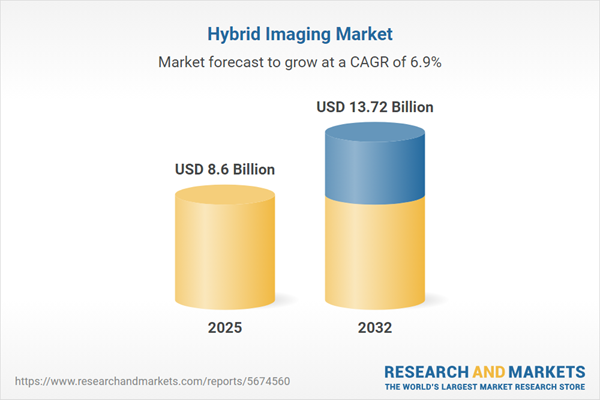Speak directly to the analyst to clarify any post sales queries you may have.
The hybrid imaging market is rapidly transforming clinical diagnostics, shaped by advancing technologies, shifting reimbursement structures, and growing demand for precision medicine. Senior leaders evaluating investments in this sector will find significant implications for operational efficiency and future-ready care pathways.
Market Snapshot
The hybrid imaging market grew from USD 8.05 billion in 2024 to USD 8.60 billion in 2025. It is expected to continue expanding at a CAGR of 6.88%, reaching USD 13.72 billion by 2032. This trajectory highlights sustained demand for integrated diagnostic modalities as providers worldwide invest in systems that deliver both functional and anatomical insights within a single workflow. The adoption of hybrid technologies is accelerated by efficiency requirements in healthcare settings and mounting clinical needs across oncology, cardiology, neurology, and infectious disease management.
Scope & Segmentation
This report delivers a thorough examination of the hybrid imaging market’s most relevant segments and geographic presence. The analysis provides a holistic lens for decision-makers to benchmark strategies and align operational priorities.
- Technology Type: PET-CT, PET-MRI, SPECT-CT
- Sales Channel: Direct sales, Distributors
- Application: Cardiology including myocardial perfusion and viability; Infectious diseases with infection site and inflammation imaging; Neurology such as epilepsy and neurodegenerative protocols; Oncology encompassing hematologic malignancies and solid tumors
- End User: Diagnostic centers, Hospitals, Research institutes
- Regions: Americas (including North America, Latin America), Europe, Middle East & Africa, Asia-Pacific
- Country Coverage: United States, Canada, Mexico, Brazil, Argentina, Chile, Colombia, Peru, United Kingdom, Germany, France, Russia, Italy, Spain, Netherlands, Sweden, Poland, Switzerland, United Arab Emirates, Saudi Arabia, Qatar, Turkey, Israel, South Africa, Nigeria, Egypt, Kenya, China, India, Japan, Australia, South Korea, Indonesia, Thailand, Malaysia, Singapore, Taiwan
- Company Coverage: Siemens Healthineers AG, GE HealthCare Technologies Inc., Koninklijke Philips N.V., Canon Medical Systems Corporation, Fujifilm Holdings Corporation, Hitachi Ltd., Shimadzu Corporation, United Imaging Healthcare Co. Ltd., Neusoft Medical Systems Co. Ltd., Spectrum Dynamics Medical Ltd.
Key Takeaways for Hybrid Imaging Stakeholders
- Integration of artificial intelligence within hybrid imaging systems is driving improvements in automated lesion detection and workflow efficiency, supporting consistent diagnostic outcomes.
- Growing use of molecular probes and multi-parametric imaging is advancing theranostic applications, expanding opportunities for drug development and treatment monitoring.
- Modular platform design allows organizations to customize and scale hybrid imaging solutions over time, supporting both cost management and technology adoption.
- Partners across the pharmaceutical and software sectors are increasingly vital for delivering comprehensive solutions that integrate analytics, cloud connectivity, and advanced visualization tools.
- Regional adoption strategies now favor managed service contracts and scalable deployment models, responding to varying infrastructure maturity across EMEA, Americas, and Asia-Pacific regions.
Impact of Tariffs and Supply Chain Resilience
Recent tariffs imposed in the United States on key hybrid imaging components have led manufacturers to adapt sourcing and pricing strategies. Organizations are prioritizing supply chain diversification and establishing regional assembly centers to mitigate cost pressures and reduce exposure to geopolitical risks. These shifts support greater access to maintenance and parts, while encouraging vendor partnerships and dynamic inventory management in an evolving trade environment.
Trends in Technology and Market Expansion
Hybrid imaging platforms are being refined through collaborative innovation with advances in detector modules and image processing algorithms. Increasing emphasis on workflow integration is matched by the launch of compact and specialist scanners for outpatient use. Companies from established and emerging economies are focusing on remote support capabilities, tailored training, and localized manufacturing, broadening the competitive field and supporting adoption in price-sensitive markets.
Hybrid Imaging Market Methodology & Data Sources
The findings in this report are based on primary interviews with industry experts, triangulation with peer-reviewed publications, and analysis of supplier and regulatory disclosures. Proprietary databases tracking equipment installations and service contracts supplement these approaches. Rigorous data validation and cross-checking ensure that insights and recommendations are based on verified evidence.
Why This Report Matters
- Enables senior executives to identify high-priority opportunities and risks across diverse hybrid imaging applications and geographies.
- Supports better capital allocation and operational planning by providing clear segmentation and technology adoption insights.
- Offers actionable pathways to strengthen competitive positioning through supply chain adjustments and collaborative service models.
Conclusion
Hybrid imaging continues to reshape clinical diagnostics through innovation, strategic alliances, and supply chain adaptation. This report provides a clear framework for capitalizing on market trends and emerging opportunities while navigating a complex global landscape.
Additional Product Information:
- Purchase of this report includes 1 year online access with quarterly updates.
- This report can be updated on request. Please contact our Customer Experience team using the Ask a Question widget on our website.
Table of Contents
3. Executive Summary
4. Market Overview
7. Cumulative Impact of Artificial Intelligence 2025
Companies Mentioned
The companies profiled in this Hybrid Imaging market report include:- Siemens Healthineers AG
- GE HealthCare Technologies Inc.
- Koninklijke Philips N.V.
- Canon Medical Systems Corporation
- Fujifilm Holdings Corporation
- Hitachi, Ltd.
- Shimadzu Corporation
- United Imaging Healthcare Co., Ltd.
- Neusoft Medical Systems Co., Ltd.
- Spectrum Dynamics Medical Ltd.
Table Information
| Report Attribute | Details |
|---|---|
| No. of Pages | 193 |
| Published | October 2025 |
| Forecast Period | 2025 - 2032 |
| Estimated Market Value ( USD | $ 8.6 Billion |
| Forecasted Market Value ( USD | $ 13.72 Billion |
| Compound Annual Growth Rate | 6.8% |
| Regions Covered | Global |
| No. of Companies Mentioned | 11 |









